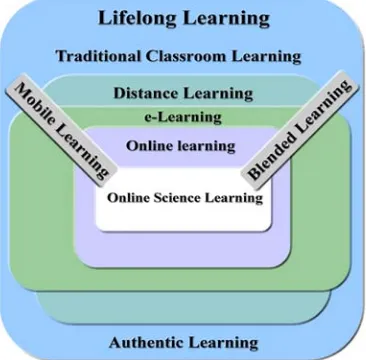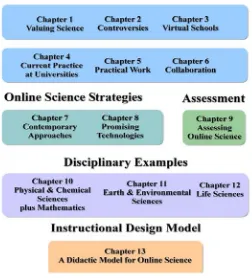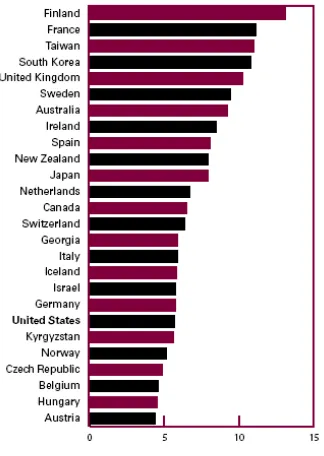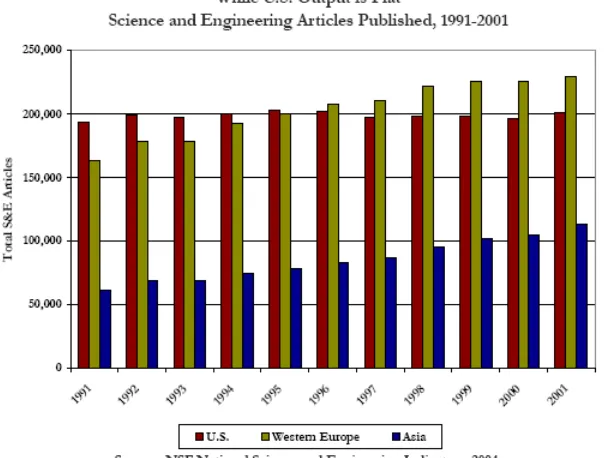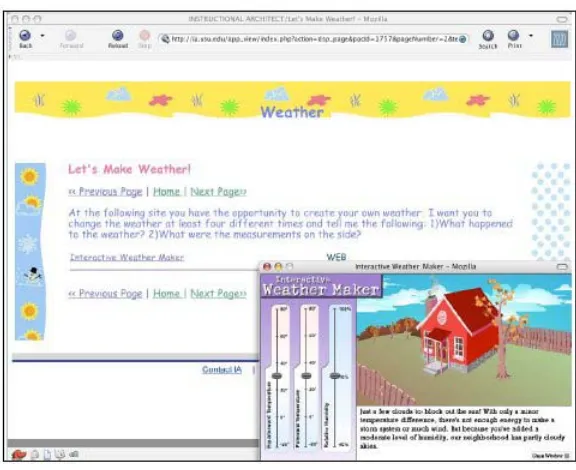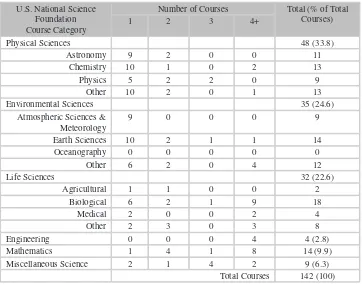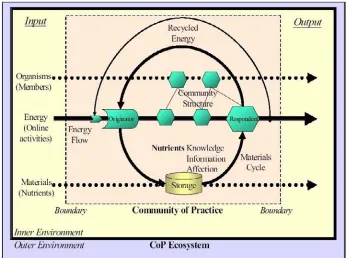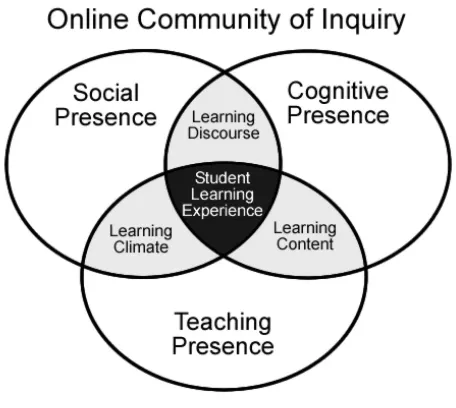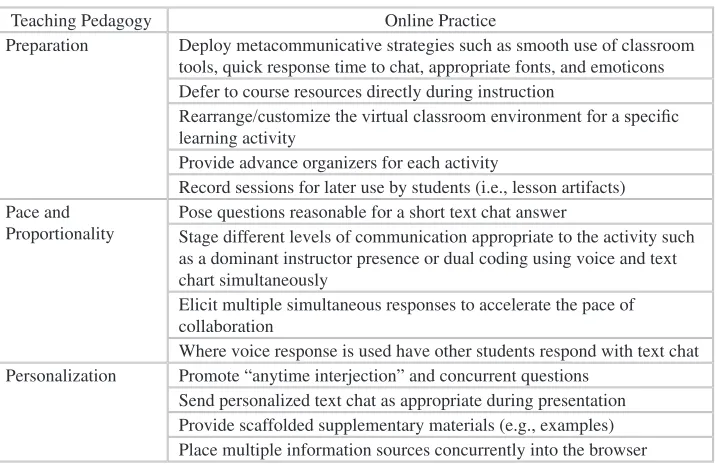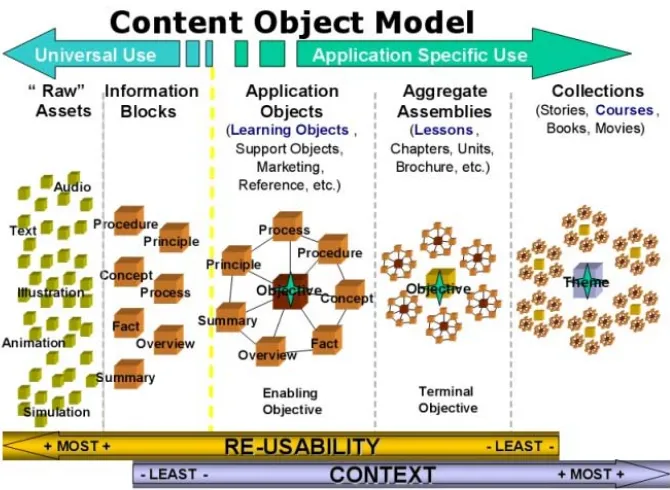Online Sc ie nc e Le a r ning:
Be st Pra c t ic e s a nd Te c hnologie s
Kevin F. Downing
DePaul University, USA
Jennifer K. Holtz
DePaul University, USA
Acquisition Editor: Kristin Klinger Senior Managing Editor: Jennifer Neidig
Managing Editor: Jamie Snavely
Assistant Managing Editor: Carole Coulson Managing Development Editor: Kristin M. Roth Assistant Managing Development Editor: Jessica Thompson Assistant Development Editor: Deborah Yahnke Editorial Assistant: Rebecca Beistline
Copy Editor: Amanda Appicello
Typesetter: Amanda Appicello
Cover Design: Lisa Tosheff
Printed at: Yurchak Printing Inc.
Published in the United States of America by
Information Science Publishing (an imprint of IGI Global) 701 E. Chocolate Avenue
and in the United Kingdom by
Information Science Publishing (an imprint of IGI Global) 3 Henrietta Street
Copyright © 2008 by IGI Global. All rights reserved. No part of this book may be reproduced in any form or by any means, electronic or mechanical, including photocopying, without written permission from the publisher.
Product or company names used in this book are for identification purposes only. Inclusion of the names of
the products or companies does not indicate a claim of ownership by IGI Global of the trademark or registered trademark.
Library of Congress Cataloging-in-Publication Data
Online science learning : best practices and technologies / Kevin F. Downing and Jennifer K. Holtz, authors. p. cm.
Summary: “This book reviews trends and efforts in web-based science instruction and evaluates contemporary philosophies and pedagogies of online science instruction. This title on an emergent and vital area of education clearly demonstrates how to enrich the academic character and quality of web-based science instruction”--Pro-vided by publisher.
ISBN 978-1-59904-986-1 (hardcover) -- ISBN 978-1-59904-987-8 (e-book)
1. Science--Study and teaching (Higher) 2. Web-based instruction. 3. Education--Computer network re-sources. 4. Education, Higher--Computer-assisted instruction. 5. Education, Higher--Effect of technological innovations on. I. Downing, Kevin F. II. Holtz, Jennifer K.
Q179.97.O55 2008 507.8’5--dc22
2007049561
British Cataloguing in Publication Data
A Cataloguing in Publication record for this book is available from the British Library.
De dic a t ion
To my wonderful wife Lisa whose passion and dedication to enriching her students’ knowledge is a constant inspiration. To my beloved sons, Alexander and Sean, with whom every second shared is the greatest joy, may your lives always be bountiful in the quest for knowledge. To Mom, Dad, Ray, and Bri, bonis avibus always. –KFD
In memory of my father, Arthur F. Peters, Jr., who dreamed of this first for himself, then for
Online Sc ie nc e Le a r ning:
Be st Pra c t ic e s a nd Te c hnologie s
Ta ble of Cont e nt s
Foreword ... ix
Preface ... xi
Section I: Science Education and Online Science Learning Chapter I Online Science: Its Role in Fostering Global Scientific Capital ... 1
Building Global Science and Technology Capital ... 2
Valuing Science Education Globally ... 3
Global Implications for Online Science Education ... 10
Conclusion... 10
References ... 11
Chapter II Controversies and Concurrence in Science Education ... 14
The U.S. Failure in Science ... 16
Additional Factors Influencing Science Education ... 19
Other Considerations that Influence Online Learning Pedagogy... 21
Issues in Learning Science ... 22
Learning Theories and Concepts ... 22
Conclusion... 27
References ... 27
Chapter III Virtual School Science ... 30
U.S. Virtual Schools ... 31
Enrichment at the Interface: Coordinated K-16 Online Science Learning ... 36
Online Professional Development for Science Teachers ... 37
Selecting, Employing, and Designing Online Science Learning Objects for Schools ... 38
Contemporary Approaches to Online Science Learning at Schools ... 40
Conclusion... 43
References ... 44
Chapter IV Taking University Science Education Online ... 49
Survey of Undergraduate Distance Science Education (SUDSE©) ... 50
Revisiting Current Practice ... 54
Conclusion... 55
References ... 56
Appendix: SUDSE Online Survey ... 58
Chapter V The Role of Practical Work in Online Science ... 73
What is Practical Work? ... 74
Where Does Practical Work Take Place?... 76
A Brief History of Practical Work in the UK and U.S. ... 76
Purpose and Value of Practical Work ... 79
Value of Practical Field Work ... 80
Additional Purposes for Practical Work ... 80
Practical Work Controversies ... 82
Designing Practical Work Tasks ... 85
Epistemological and Procedural Introduction to Practical Work... 86
Example: Employing Situated Cognition and Scaffolding in Practical Work ... 87
Conclusion... 88
References ... 89
Appendix: Compilation of Learning Outcomes for Practical Work ... 93
Chapter VI Knowledge Transfer and Collaboration Structures for Online Science ... 98
Collaborative vs. Cooperative Online Learning ... 99
Online Collaboration ... 100
Collaborative Learning and Online Science ... 101
Stages and Models of Online Collaboration ... 101
Effective Approaches to Collaboration and Group Structures ... 104
Social Software for Online Science ... 106
Role of the Instructor in Online Collaboration ... 107
The Sage on the Stage Lives? ... 107
E-Moderating ... 108
Gesture and Silence in the Online Science Classroom ... 108
Using Collaboratories to Enrich and Sustain Science Knowledge ... 109
Collaboration in Virtual Worlds to Support Science Learning ... 110
Live Online Classrooms ...111
Science Collaboration Miscellany ... 113
Evaluating Online Science Collaboration ... 113
Conclusion... 114
References ... 115
Section II: Online Science Instructional Strategies and Technologies Chapter VII Online Science: Contemporary Approaches to Practical Work ... 121
Learning Objects ... 122
Learning Objects Classification ... 123
Learning Object Repositories ... 124
Multimedia ... 124
Streaming Digital Video in Online Science ... 125
Typologies for Web-Enabled Science Laboratories ... 126
Benefits of Simulations in Online Science Learning ... 129
3-D Learning Objects as Simulated Specimens ... 129
Additional 3-D Learning Objects for Online Science Learning ... 132
3-D Virtual Worlds ... 133
Caveats of Using Virtual Worlds ... 135
Affordances of Virtual Science Environments ... 135
Examples of Online Virtual Science Learning Environments ... 136
Educational Science Games ... 137
Models for Online Learning Game Development ... 137
Remote Experimentation ... 139
Remote Experimentation: Design Approaches and Considerations ... 139
Examples of Remote Experiments ... 141
Remote Experiment Affordances ... 142
Hands-on Laboratory Approaches for Online Students ... 143
Virtual Field Trips ... 145
Actual Field Study to Support Distance Education... 147
Virtual Puzzles for Learning Science ... 149
Hybrid or Blended Science Courses ... 150
Digital Libraries and Repositories for Science Education ... 151
Conclusion... 152
References ... 153
Chapter VIII The Cutting Edge: Promising Technologies and Strategies for Online Science Education ... 159
Emerging Learning Systems for Online Science Education ... 161
Remote and Virtual Experimentation to Support Student Research... 163
Mobile Technologies for Online Science Education ... 164
Using PDAs and iPods® in Online Science ... 166
Mobile Learning Objects... 167
Emerging 3-D Learning Environments ... 171
Haptic Design... 178
Virtual Instructors, Classmates, and Tutors ... 180
Virtual Science Museums and Science Centers ... 184
Trends ... 186
Impact of Online Technological Innovation to the Science Professoriate ... 186
Conclusions ... 187
References ... 187
Section III: Assessing Online Science Learning Chapter IX Assessing Science Competence Achieved at a Distance ... 196
Assessment Standards and Science Assessment ... 197
Novice-to-Expert Knowledge ... 198
Aligning Content, Instruction, and Assessment ... 199
Interpretive Assessment Online ... 201
Online Science Assessment Cases ... 204
Conclusions ... 211
References ... 212
Section IV: Disciplinary Examples in Online Science Courses Chapter X Online Mathematics and Physical Science (Mathematics, Astronomy, Chemistry, and Physics) ... 216
Designing Online Math Learning Activities ... 217
On the Design of Physical Science Learning Activities ... 218
Courses ... 219
Simulations and Virtual Labs ... 224
Collaborations, Virtual Science Museums, and Digital Libraries ... 234
Trends and Conclusion ... 238
References ... 239
Chapter XI Online Geoscience ... 242
Courses ... 243
Virtual Field Trips ... 246
Virtual Laboratories ... 250
Collaboration, Virtual Science Museums, and the Cyberinfrastructure ... 256
Collaboration ... 257
Virtual Science Museums ... 258
Cyberinfrastructure ... 260
Chapter XII
Online Life Sciences ... 265
Courses ... 266
Virtual Field Work and Laboratories ... 273
Online Resources ... 285
Trends and Conclusion ... 287
References ... 287
Section V: Best Practice Model for Online Science Learning Chapter XIII A Didactic Model for the Development of Effective Online Science Courses... 291
Considerations ... 293
Phase 1: Course Planning ... 293
Phase 2: Design ... 298
Phase 3: Implementation... 304
Phase 4: Course Assessment and Redesign ... 309
Conclusion... 310
Epilogue ... 312
References ... 312
Appendix: Model Planning Documents ... 317
About the Authors ... 338
Fore w ord
In November 2007, the Inaugural Conference of the International Mind, Brain and Educa-tion Society (IMBES) was held in Fort Worth, Texas. Its purpose was to foster collaboraEduca-tion between practitioners and researchers in the neurosciences, cognitive sciences, and similar fields. Interestingly, and unlike past practice, educators were also included in this group. Each of us knows “default educators,” members of any given profession who believe, because they completed their own professional program, that they can teach in their field. There is no doubt that some are able to do so—a few are remarkably talented—yet many are not. In Online Science Learning: Best Practices and Technologies, we hear from two scientists who made the deliberate decision, years ago, to embrace professional education praxis.
The praxis of Downing and Holtz is matter-of-fact, yet thorough, much like the authors themselves. These are researchers and educators who read widely, think globally, and act locally. They use the tenets presented here in each of their courses, whether online or on-site in format, and whether learners are adult or traditional-aged. In fact, Kevin Downing’s emphasis on experiential learning in science made him instrumental in establishing their current online program, and Jennifer Holtz’s previous work with resident physicians informed her current practice philosophy.
Their lack of credence with more ephemeral aspects of education and learning theory is palpable, yet they clearly identify valuable features from behaviorism, cognitivism, and constructivism, typically those based on reproducible research. These they merge with neurological advances in learning to posit neuro-cognitive instrumentalism, a learning theory that emphasizes hypothetico-predictive behaviors that current evidence supports as naturally occurring. Their work is well grounded in both contemporary and classic education and learning literature, yet it requires us to think differently, more inventively, about ideas that we believe we understand.
have application to secondary, as well as tertiary, education applications that could improve the state of science education for all learners, regardless of the method of instruction.
W. Franklin Spikes, Ed.D. Professor & Director
Doctoral Program in Adult Education Kansas State University
Pre fa c e
Purpose
There is an enormous and swiftly growing literature for online learning practices, but rela-tively little attention has been paid to the special attributes and pedagogy of online science at the community college and university level. As regular authors of natural science courses and instructional materials for the online program for adults at DePaul University, we have long wondered why there was no up-to-date and expansive examination of the best practices in online science learning for university faculty, no general survey of current and emerging technologies for teaching science online, little consideration of the role of online science education as a burgeoning force for building American and global science capital, and no pragmatic models to inform the comprehensive development of online science programs, courses, and constituent learning activities. This book concentrates on this void by providing a general treatment of online science learning in the sciences—a subject area we affirm is an emergent and vital area of science education. While we review and incorporate selected examples from vast literature in computer science and engineering, we have purposefully constrained the chief focus of our treatment to online science learning in the natural sciences. The other fields within the science, technology, engineering, and mathematics (STEM) knowledge areas are certainly deserving of comprehensive treatments of their own online learning practices, but are beyond the scope of this book. Likewise, while our approach is largely U.S. in focus, we have tried, whenever possible, to incorporate non-U.S. consider-ations and concerns, and hope that this effort is apparent.
Educational Context
revolution in communication and information technologies (CIT). The rapid proliferation and tacit acceptance of online instruction in higher education and school instruction has effectively made the terms “distance education” or “distance learning,” in practical usage, synonymous with “online learning”. Likewise, the term “distance education” is often used interchangeably but unsuitably with “e-learning”, which is actually learning that relies on CIT technologies in a variety of contexts; thus it significantly overlaps, but not necessarily involves, distance education (Guri-Rosenblit, 2005).
In the hierarchy of learning forms in the “lifelong learning” framework (Figure 1), online science learning is nested within distance learning, e-learning, and online learning, respec-tively. Other important learning types such as blended learning (also called hybrid and mixed) and mobile learning (also called m-learning) can also be used in conjunction with online science learning.
Organization and Character of the Book
Online Science Learning: Best Practices and Technologies is organized into five sections (Figure 2) spanning: (1) fundamental issues and concepts in online science learning, (2) emerging online science practices and technologies, (3) assessment of online science activi-ties, (4) current online practices in mathematics and natural science disciplines, and (5) a detailed instructional design model to develop online science activities. Section I reviews the value of science education in terms of scientific capital. It also evaluates global and national
trends in both science and online science education. In addition, this section examines the epistemological and pedagogical foundations of online science and introduces the character of online science in schools. In the final chapters of this section, contemporary online science practices in higher education are investigated and the essential topics of practical work and collaboration are reviewed from the online science perspective.
In Section II of this book, we appraise and provide examples of contemporary approaches in online science instruction and review emerging technologies that may soon significantly affect the character of how science is taught online. Our book’s Section III provides a review of best practices in online assessment of learning, including specific applications to online science learning. In Section IV, we compile and review a substantial number of best practice cases of online science from recent publications in the physical and chemical sciences, earth and environmental sciences, and the life sciences. Our book’s final section is devoted to presenting an instructional best practices model for developing online science exercises, courses, and programs. Our model is didactic and derived from a hypothetico-predictive philosophy consistent with the neurological basis of human learning. This section also provides course authors and designers developmental worksheets to aid in the various designs or redesign phases of an online science course or learning activity.
Online science learning can be a remarkably visual-rich experience and we have attempted to bring some of its vitality through to the reader with the graphics used. We note that our publisher’s cost considerations prohibit a printed color version of this book. However, the reader is encouraged to access the digital rendering of this book, which is principally in color.
A brief description of each of the chapters follows:
Chapter I provides an overview of the state of global science capacity and online science education initiatives designed to increase that capital, with emphasis on developing countries. We briefly describe the valuation of science education, and establish a base from which advances in online science education is explored in the remaining chapters.
Chapter II evaluates trends in online science education within the context of the biggest is-sues in contemporary science education, the ongoing debate about the definition of science, the proper role of science education and the steps necessary to correct the science gap in the United States. Almost by definition, this controversy falls along theoretical camps—the variety of constructivists versus the movement toward a hypothetical-predictive learning theory more tightly bound to the neurological (i.e., biological) source of learning.
Chapter III provides the reader a foundational look at the contemporary character and role of online science learning in virtual schools. With an emphasis on secondary schools, we examine the interdependence and existing obstacles to seamless K-16 science instruction. The affordances of the online science environment to generate a more connected science education strategy for students from K-12 through their university studies are investigated, including the crucial area of professional development for science teachers. To illuminate the salient similarities in the character and efforts between online science learning at schools and universities, we conclude this section with a comparison of practices and technologies applied commonly to each. We offer general guidance on areas of online science learning that can be capitalized on to improve student learning in science within our schools. Chapter IV presents an investigation of the current use of cutting-edge science technologies and explores the pedagogical foundations of online science education that effect how use choices are made. We examine strategies consistent with the neurological basis of learn-ing linked to hypothetical-predictive processes and where those strategies are currently utilized.
Chapter V reviews and defends the concept of practical work and its use to support online science instruction. We review practical work’s historical foundation, purpose, and value, as well as controversies concerning practical work’s utility in science instruction. This chapter builds a rationale for practical work’s intentional implementation in online science learning environments and supports subsequent chapters that review current and emerging approaches and technologies to support online practical work.
Chapter VIII reviews and encourages the use of innovative technologies to promote effec-tive online science learning. This chapter considers the outlook for the character of online science learning in the near future synthesizing recent research in the CIT and online tech-nology areas.
Chapter IX reviews current and emergent best practices in online learning assessment, notes similarities in on-site and online methods, and explores the differences and how those dif-ferences are or can be addressed. Particular attention is paid to the assessment of typical online science activities (e.g., practical work) and troublesome theory incongruities (e.g., discrete knowledge).
Chapter X provides a review of best practice cases in online science from mathematics and the physical sciences. Examples are grouped into the chief areas: courses, simulations, vir-tual laboratories, collaborations, virvir-tual science museums, and digital libraries. This chapter provides a foundation of resources to consider in the development or redesign of math and physical science learning activities and courses.
Chapter XI’s focus is to present a more discipline-centered review of representative pub-lished examples from the geosciences. Our review takes account of courses, virtual field trips, virtual laboratories, collaboration, virtual science museums, and the relationship of the cyberinfrastructure to the geosciences. This chapter provides a variety of resources to consider in the development or redesign of online earth and environmental science learning activities and courses.
Chapter XII reviews representative published examples from the life sciences. Our review takes account of courses, virtual field trips, virtual laboratories, collaboration, and virtual science museums. Our goal is to provide the reader with an appreciation of the best practices, innovations, and initiatives in online science in the life science area.
Chapter XIII presents our didactic model for online science instruction based upon best practices in both science education and online education coupled with insights from the diverse and substantial literature reviewed in previous chapters. We blend concepts of distance education and science into a practical model that addresses the learning needs of major and non-major students, and the instructional design constraints of their instructors and institutions. We approach the instructional design topic with the assumption that the published online modalities included herein are generally effective as presented, but have noted evidence of ambiguity, where found. The summation of this treatment is an integrated model that takes into account emerging ideas about the neurological basis of human learning and consideration of the different philosophies of science education, although we make no apologies for holding a particular perspective. Our chief goal is to present the reader a process flow and supporting development tools through key course design steps bringing together original learning design structures with sensible best practices from the literature.
Who is This Book For?
whether fully online or blended. Accordingly, we provide both a theoretical and practical background on online science learning as well as a model for course development. Moreover, we have deliberately presented many of the best practice cases organized by key scientific areas so that science educators can get a quick view and be inspired by contemporary best practice examples in their own mathematics or natural science disciplines. Although our perspective is through the window of science, our hope is that practitioners of online learn-ing from other disciplines will also find the topics, review of technologies, and strategies informative.
In addition, this book should be useful for instructional designers involved with the develop-ment of online scientific materials. We anticipate that this book will enhance the dialogue between instructional design staff and science faculty. Utilizing this book’s analysis of practical work and collaboration as well as its review of socio-economic (i.e., valuation) aspects of science, trends in online science, and online science pedagogy; this tome can be employed as an effective resource or text for education department courses on science at the upper division and/or graduate level. Similarly, with the rapidly growing interest in augmenting K-12 education with online activities and resources, this book is also intended as a reference for secondary school educators and administrators. Lastly, we share deeply in the concern regarding America’s “failure” in science education over the last few decades and its long-term consequences for America’s prosperity. Consequently, this book is intended to inform and motivate policy makers to explore and make the most of this important and emerging area of science instruction to increase scientific capital, both here and abroad.
Kevin F. Downing Jennifer K. Holtz
DePaul University, Chicago, USA October 2007
References
Bell, R., & Tight, M. (1993). Open universities: A British tradition? Buckingham: The Society for Research into Higher Education and Open University Press.
Ac k now le dgm e nt s
Section I
Chapter I
Online Science:
Its Role in Fostering Global
Scientific Capital
Concern for man and his fate must always form the chief interest of all technical endeav-ors…Never forget this in the midst of your diagrams and equations.
– Albert Einstein (1879-1955)
Health and illness, flood and drought, want and plenty: each of these dichotomies rests squarely within the province of science education, for science education enables one to think critically and creatively, to collaborate, to investigate, to solve real-world problems, and to apply a body of knowledge that is dynamic and that rewards the lifelong learner with its challenges.
However, advances in myriad science and technology fields are not uniform, just as science education is not uniform (Schulman, 2002; UNESCO, 2004). Where Southeast Asia advances, for example, much of the Middle East lags. Science capacity is, truly, global capital, yet capacity must be meaningfully applied in order to be sustainable and carry worth. It has been said, “A Nobel Prize for science will do little by itself to alleviate poverty or gener-ate new business in developing countries,” (Watkins, Osifo-Dawodu, Ehst, & Cisse, 2007, para. 4), emphasizing that science without actionable purpose accomplishes little. In fact, developing countries often lose their most highly skilled scientists to institutions that offer better salaries and the potential for revolutionary work.
In this chapter, we provide an overview of the state of global science capacity and online science education initiatives designed to increase that capital, with emphasis on developing countries. We see the online environment as a connective tool to bridge very large gaps in wealth and capacity, an educational bootstrapping mechanism that has not yet been fully tapped. We briefly describe the valuation of science education, and establish a base from which advances in science education will be explored in the remaining chapters.
Building Global Science and Technology Capital
Whether eliminating hunger or developing global partnerships, the concerted effort to meet the needs of the world’s population requires that those who serve and are served have the ability to take advantage of opportunities developed. That ability is capacity and capacity evolves from education.
With increasing frequency, officials in low and middle income countries are coming to the
conclusion that they must build up their science, technology and innovation (STI) capacity in order to make demonstrable progress in achieving the Millennium Development Goals (MDGs); raise productivity, wealth, and standards of living by developing new, competi-tive economic activities to serve local, regional, and global markets; and address social,
economic, and ecological problems specific to each country (Watkins, Osifo-Dawodu, Ehst
& Cisse, 2007, para. 4).
Agricultural and environmental husbandry, access to energy and access to health care are the most visible needs of those in developing countries, yet foundational to these are infrastruc-ture—both regulatory and physical, and collaboration—both as internal, public support and external partnerships (Watson, Crawford, & Farley, 2003). The World Bank identifies four essential factors for successful development of human capital, environments, and support systems that facilitate innovation:
• Research and development (R&D): Producing and acquiring economically relevant knowledge mandates activities that lead to applied, rather than theoretical knowl-edge;
• Technology acquisition and diffusion: Using existing knowledge to improve industrial competitiveness “focus(es) on helping the private sector absorb and utilize technology that is already in use elsewhere in the world” (Science, Technology, and Innovation, 2007, para. 5); and
• Science and technology policy making capacity refers to the ability of policy makers to “understand the challenges and opportunities flowing from the global economy and to devise appropriate policies” (Science, Technology, and Innovation, 2007, para. 6).
Underlying each of these factors is education and the use of knowledge at multiple levels in science, technology, and innovation, each of them problem-based and solution-oriented. An example of operationalizing the four factors outlined by the World Bank is Juma’s (2007) description of infrastructure initiatives that incorporate funding for engineering education, one way of addressing the World Bank’s emphasis on sustainability at the local level. Juma identifies key elements as road and rail construction and upgrades, improvements to ports and harbors, and enhanced telecommunication systems.
Lindholm (2007) describes a combination public-private economic collaboration that re-vitalized an area of the former East Germany, relying heavily on existing, underemployed scientists and entrepreneurial-minded intermediaries who could facilitate collaboration. Both Lindholm (2007) and Juma (2007) stress the importance of having in place people who can identify strategic opportunities and people to forecast human capacity needs. In fact, the importance of growing the numbers of variously skilled workers is a common point in development, one also stressed by the World Bank. They characterized it as, “Producing knowledge intensive, technologically sophisticated, higher value goods and services is not possible without a trained management cadre and labor force with the appropriate mix of technical and vocational skills” (Science, Technology, and Innovation, 2007, para. 2). Such a group would, by necessity, include scientists experienced in research and development, and engineers and technicians to adapt and use the resultant technologies for specific pursuits. To that end, “vocational, secondary and tertiary education must all contribute to turning out graduates with the necessary skills. Moreover, since the skills required by today’s labor market may not be the same as those that will be required in the future, a process of lifelong learning must be built into the education system. And at all levels and life-cycle stages, the education system must work with the private sector to understand and respond to its needs” (Science, Technology, and Innovation, 2007, para. 2-3).
Valuing Science Education Globally
modernization among the world’s nations. While their framework is explored in more detail in Chapter IV, a brief introduction here to the valuation model helps put the importance of global examples into perspective.
The examples described in preceding sections represent use value. Science education is of direct use value to those who utilize science education in professional science or a career that integrates science knowledge, those who use science knowledge as one comprising an informed citizenry, or for personal enjoyment or avocation. Career applications are evident in both the Juma (2007) and Lindholm (2007) examples. Indirect use value is manifest in infrastructure, commodities, and the general application of science knowledge to societal functions for the common good, again evident in both Juma (2007) and Lindholm (2007). Option use value refers to untapped potential, as Lindholm (2007) described.
The conservation value of science education, despite its connotation of a lack of immediacy, is just as crucial to developing countries and areas in need of revitalization. Bequest con-servation value refers to the benefit gleaned by future generations from what is done today, a key motivating factor in the development efforts described. Existence conservation value recognizes the worth of science education as a force for reason or progress, what Watkins, Osifo-Dawodu, Ehst, and Cisse (2007) describe as the motivating force for countries on the verge of development. Finally, intrinsic conservation value holds perhaps the weakest position in science education immediacy, referring as it does to, as we state in Chapter XIII, “the natural quest of understanding of a thinking organism.” Science education is of intrinsic value because it enables the educated person to conceptualize issues larger than the immedi-ate, larger than self or of any economic consequence. These valuations are also clearly seen in the science education initiatives occurring throughout the world and, sadly, in those areas without such initiatives, where the lack of use value efforts affects the current populace, but the lack of conservation value efforts bodes ill for subsequent generations.
Much of our treatment of online science addresses and incorporates examples from the U.S., UK, and Europe. To provide a broader view of the efforts and the informational technology infrastructure that will assist in building global scientific capital, we present next brief summaries from other regions, particularly in developing countries. These initia-tives are usually part of a larger, more comprehensive aid package that addresses health, infrastructure, and education needs, often—especially in the cases of World Bank and the United States Agency for International Development (USAID)—also addressing a variety of needs related to capacity building.
Middle East Scientific Capital
Harnessing the region’s human and social capital so that it can take its place among today’s
leading knowledge economies will take less financial investment than policy reform: trans-forming education systems to meet the demands of a global economy driven by advances in knowledge and technology; encouraging private businesses to invest in research and development; creating business and research set-ups that foster innovation (Sarbib, 2002, p. 1).
There are exceptions; sophisticated information and communications technology (ICT) is found in the oil-rich Gulf States, where options for students are more numerous (Taqrir Washington, June 13, 2007). Dubai Internet City (DIC) offers what it calls a “one-stop-shop environment” for technology oriented international businesses, while incorporating a national development plan (The Career Centre, 2007). Away from the Gulf States, and among those disenfranchised by cultural mores, options are fewer. It is, indeed, ironic that Arab countries find themselves with such wide disparity both among themselves and their economic classes, and between themselves and the industrialized world, considering the role of Arabic culture in fostering scientific and mathematical advances prior to the Renaissance.
Jordan
While not specifically science education-oriented, Jordan’s Education Reform for Knowl-edge Economy (ERfKE) program is designed to increase the overall capacity of Jordanian primary and secondary students, better positioning them for higher education. Now in its fourth year, ERfKE is comprised of components that address Sarbib’s (2002) concern for policy reform, including provision of ICT for student use (Education Reform for Knowledge Economy I Program, 2003).
The first component is significant in that it addresses overall policy and the refinement of systems responsible for policy implementation, including an effective decision support system and “comprehensive and coordinated educational research, policy analysis, and monitoring and evaluation activities” (Education Reform for Knowledge Economy I Program, 2003, para. 3). The second ERfKE component encompasses revised curriculum and assessment, the provision of professional development and learning resource development and acqui-sition including, with the third component, the need for both computer and science labs. Component 3 also provides for a sufficient number of safe, uncrowded schools, which, with the fourth component, “promotes readiness for learning through early childhood education. It is designed to enhance equity in low-income areas by providing kindergarten for children of age 5” (Education Reform for Knowledge Economy I Program, 2003, para. 3).
Lebanon
technology (Research Around the World: Lebanon, 2007). The project is an initiative of the U.S. State Department’s Middle East Partnership Initiative (MEPI), with equal funding from each university and additional assistance from the U.S. Agency for International Develop-ment (USAID) (U.S. DepartDevelop-ment of State, 2006).
Tunisia and Egypt
Tunisia’s Education Quality Improvement Program (EQIP) is dual-phased, with Phase 1 having closed in 2006. Project evaluation documents classified the initial phase as satisfac -tory in meeting the three project goals:
• Achieve near-universal completion of basic education (Grade 1 through 9). • Provide a greater number of students with opportunities for post-basic education. • Modernize the sector in ways that improve the quality of outputs and the efficiency
with which they are produced (Education Quality Improvement Program, 2000).
Both EQIP Phase 2 (2004) and Egypt’s Higher Education Enhancement Project (2002) are similar to Jordan’s ERfKE program in scope, particularly in improvement of infrastructure for subsequent development initiatives.
Russian Federation Scientific Capital
While the core centers of Russia itself and the former Soviet Union (e.g., Moscow, St. Petersburg, Volgograd) have a rich history of science investigation and science education, the areas currently comprised of republics and regions that are more isolated have long suf-fered from a dearth of options. Two collaborative initiatives seek remedies. The Education Reform Project, in collaboration with the Russian Federation’s Ministry of Education (now the Ministry of Education and Science), seeks to reform existing infrastructure and policy, while initiating what the West knows as vocational education. Specifically, the goals of the project are to “improve quality and standards; promote the efficient and equitable use of scarce public resources for education; modernize the education system (structure of network and institutions); improve the flexibility and market-relevance of initial vocational educa-tion” (Education Reform Project, 2001, para.5).
The E-Learning Support Project (2004), working with the Ministry of Education and Science, “seeks to improve the accessibility, quality and efficiency of general and initial vocational education,” through ICT (para. 8).
• Building sustainable Russian capacity to produce high quality, affordable and flexible learning materials…
• Establishing in project regions a network of resource centers which would improve regional access to ICT enhanced education opportunities and dissemination of new teaching practices (E-Learning Support Project, 2004, para. 9).
The British Council’s Faulkes Telescopes Project established a collaborative with urban Russia that has the potential for outreach to more remote areas as ICT infrastructure de-velopment permits. Users access the remote-controlled telescopes, located in Hawaii and Australia, through a control center in the UK, transmit commands and then receive the requested images through Microsoft® (Redmond, WA) or Apple® (Cupertino, CA)
operat-ing systems. Professional astronomers collaborate with individual schools, workoperat-ing with teachers and students to identify a suitable research project. Designated projects require hands-on activity by teachers and students, including data collection “which will contribute to finding answers to research questions which are of interest to professional astronomers. Through a new website, ‘Hands-On Universe, Russia’, schools and astronomers will share and discuss their findings with each other and with schools and astronomers in the UK and across Europe” (Faulkes Telescope in Russia, 2006, para. 3).
Southeast Asia Capacity
As in the Middle East, development across Southeast Asia is neither uniform nor universal, although the past decade has witnessed tremendous growth and a comprehensive study of the region was recently completed (UNESCO, 2004). Australia, South Korea, and Singapore are vigorously engaged in science education, with special emphasis on distance science education. Typically, “almost all classrooms are equipped with computers and other ICT tools; the student/computer ratio is high; Internet access is available in all schools; cur-riculum revision ensures nationwide ICT integration; delivery of education is increasingly online” (UNESCO, 2004, p. 9). Later chapters include work from some of these countries, as we discuss standards for best practices (Clark & James, 2005; Rich, Pitman, Gosper, & Jacobson, 1999).
Surprisingly, the same UNESCO study found that Japan, typically considered an academic powerhouse, was joined by China, Thailand, Malaysia, the Philippines, and India in a second, less vigorously engaged group. These countries each had developed national ICT education policies, with goals and objectives, but had not yet fully integrated ICT.
Other countries (e.g., the Vietnamese peninsula) are in the early stages of ICT development or “have no relevant policies but are running pilot ICT projects. In both instances, however, there is insufficient budget to implement policies and work plans and ICT infrastructure and penetration are poor” (UNESCO, 2004, p. 9).
African Capacity
development or infrastructure, rather than science education or promotion of science field-specific promotion. An important initiative that was approved as recently as July 2007 for a six-year period is the Niger Basin Water Resources Development and Sustainable Ecosystems Management Project (2007). As with many of the initiatives worldwide, the first component of the initiative is devoted to “institutional strengthening and capacity building,” specifically in and between the Niger Basin Authority and existing water management entities within the existing national and regional governments (2007, para. 4). The second component then focuses on “rehabilitating and upgrading the existing large water infrastructure” (para. 5), specifically the Kainji and Jebba dams and power plants. An integral aspect continues the focus on capacity by assessing optimization and management options for those structures. Finally, the third component focuses on “sustainable management of selected degraded ecosystems and rehabilitation of small water infrastructure” (2007, para. 7). Similar Global Environmental Projects are underway throughout Africa; while the initiatives do not spe-cifically incorporate science education, they develop the infrastructure to accommodate learning environments.
An anticipated project is Tanzania’s Science, Technology and Higher Education Reform Program (2007), with the broad outcome of “education for the knowledge economy” (para.1), focusing exclusively on tertiary education. A similar development initiative already under way in Uganda is the Millennium Science Initiative (2006), the objective of which “is for Ugandan universities and research institutes to produce more and better qualified science and engineering graduates, and higher quality and more relevant research, and for firms to utilize these outputs to improve productivity for the sake of enhancing Science and Technology-led (S&T) growth” (para. 2). What neither project does is combine distance technologies with science education, although their efforts are foundational for potential distance education and complements the distance learning initiatives in Mauritania and Burkina Faso. These two projects are similar in that each tests the viability of distance learning in situ, with clear implication that its acceptance is an uncertainty.
Description of Burkina Faso’s Development Learning Center Project (2002) pointedly ad-dresses foundational goals, to determine “its ability in approaching international knowledge, to improve implementation of the Poverty Reduction Strategy Paper (PRSP) Bank financed projects, and in the coordination of local training institutions as regards national capacity building policy” (para. 4). Every element of the infrastructure was supplied in the first com -ponent, including the laying of electrical and telecommunication lines, and construction of the actual building. In the second component, operating costs for three years were provided on a decreasing basis, to include staff training, development of operational structures and initial program development; the third component included evaluation and measurement. The center opened in June 2006, with its initial programming scheduled for the subsequent fiscal year, pending a request for at least 24 months of additional funding (Status of Projects in Execution FY06, 2006).
of the reporting period, the Center recovered 55% of its operating costs after 30 months of operations and its revenues are increasing” (Status of Projects in Execution FY06, 2006, p. 370). Demand for use of the system is increasing and has led to development of a portal for distance access (Status of Projects in Execution FY06, 2006).
Central and South American Capacity
As in Africa, most initiatives in Central and South America address not science capacity or access to distance education in the sciences, but basic health, education, and welfare needs. Peru’s Rural Education Project (2003) is not specifically science oriented, but in the first component addresses foundational issues of education equity and quality, followed by improved accessibility through distance delivery of secondary education. Teaching quality in rural areas comprises the second component, followed by a third component focusing on reform of education management and policy, “motivating linkages towards educational standards, by supporting school development, within the national assessment system, through strategic analysis and policy research” (Rural Education Project, 2003, para. 3). Mid-term review found mixed results, with rural initiatives showing lesser progress (Status of Projects in Execution FY06, 2006).
Similarly, Brazil’s Ceara Basic Education Quality Improvement Project (2000) demonstrated mixed results by 2006, with indication that there had been recent, rather than consistent, improvements (Status of Projects in Execution FY06, 2006). The Ceara project consists of four components, initially focusing on educator development and early childhood prepara-tion, then moving into televised access and accelerated programs for adult learners, with substantial investment in both educator in-service and development of teaching tools and processes. The revised priorities reported are not detailed, but the report’s omission of ac-celerated program development may be telling.
Yet, Chile’s Life-long Learning and Training Project (2002) is successfully providing young adults with basic and secondary education opportunities, with certification options, as well as “...vertical articulation of technical secondary, with tertiary technical-professional education, through the establishment of technological curricular disciplines. As well, the horizontal articulation of technical secondary, and tertiary education with the labor market, will be constituted through regional networks of educational institutions at the technical, secondary, and tertiary levels” (Life-long Learning and Training Project, 2002, para. 4). Mid-term review documented that these programs are, in fact, realized (Status of Projects in Execution FY06, 2006).
Global Implications for Online Science Education
It is clear that a global cyber-infrastructure does not exist and that developing nations are in many cases far from capitalizing on the connectivity to online distributed scientific knowledge and education resources that could spur innovation, thus improving economies and the quality of life. In some cases, as evidenced by the reports provided and many others not included, social and geopolitical forces impede such development, yet an increasing number of initiatives ranging from foundational to implementation stage are found around the world. In part, disparity in infrastructure is what prevents full implementation of the innovations explored in the remaining chapters of this book. Such useful learning objects as animations, 2-D and 3-D visualizations and streaming audio and video are the principal alternatives to traditional experiential learning and practical work that make distance science education possible at levels beyond the conceptual. Simple, blended, and Web-facilitated courses are possible with basic Internet access, which would also support elementary, e-mail-based collaboratories. The lack of flexibility inherent to simple ICT infrastructures is invisible—indeed, empowering—to those whose pedagogical options are limited, but such inflexibility restricts them from emerging best practices.
In addition to the absence of technological infrastructures, much of the world is restricted from emerging best practices simply because of a lack of collaboration between educators and ICT developers, which is typically unintentional. As we found in our own institution, ICT developers often know what is possible, but lack an application, while educators know what students need, but are unaware of the extent to which ICT can meet those needs. Furthermore, neither has fully explored the pedagogical foundations, including assessment issues, of hybrid and fully online courses, although isolated attempts are underway (Holli-man & Scanlon, 2004). These disconnects might very well change as a result of emerging inquiry into collaboratory design of learning interfaces.
By no means is the developed countries’ lack of pedagogical and technical integration meant to minimize the challenges faced by developing countries. On the contrary, the com-paratively slow pace of implementation bodes well for those countries currently securing infrastructure, as it enables them to enter the field of distance learning on a par with much of the world, having learned from the mistakes of others and with a clear path to bootstrap the way to practices that are pedagogically and financially sound. Many of the innovations explored in later chapters fall short of the sophisticated multimedia currently considered state of the art, but sparsely employed.
Conclusion
isolated areas or circumstances, is a worthy goal, one to be embraced by both governments and agencies with the resources to help those governments.
The agencies and, increasingly, the governments, consider science education a key to ca-pacity building and development, and those discussed—as well as others not mentioned, but at a similar developmental level—are well positioned to take advantage of emerging technologies that impact best practices in distance science education. As will be discussed in later chapters, there are those who question the verity of this position, and who consider science capacity a neutral element, at best. Moreover, the very definition of science and its importance to a large segment of the world’s populace is considered by critics to be debatable. However, we maintain that only those countries with the most highly sophisticated science capacity have both the time and freedom to concern themselves with innovations in science education, and the results, as later chapters explain, are of varying quality. To those in need, the philosophical debate on the purpose of science education is, rightly, merely specious.
References
Bateman, I., & Willis, K. (Eds.). (1999). Valuing environmental preferences: Theory and practice of the contingent valuation method in the US, EU, and developing countries. Oxford: Oxford University Press.
Bush, V. (1945). Science, the endless frontier. Washington, DC: U.S. Government Printing Office. Retrieved July 28, 2007, from http://www.nsf.gov/about/history/vbush1945. htm#summary
Clark, I. & James, P. (2005). Blended learning: An approach to delivering science courses online. Paper presented at Breaking Down Boundaries: A Conference on the International Experience in Open, Distance and Flexible Learning, Adelaide, South Australia. Development Learning Center Project. (2002). The World Bank Project P076159. Retrieved
July 21, 2007, from http://web.worldbank.org/external/projects/main?pagePK=64283 627&piPK=73230&theSitePK=40941&menuPK=228424&Projectid=P076159 Education Reform for Knowledge Economy I Program. (2003). The World Bank Project
P075829. Retrieved May 27, 2007, from http://web.worldbank.org/external/projects/ main?Projectid=P075829&Type=Overview&theSitePK=40941&pagePK=64283627 &menuPK=64282134&piPK=64290415
Education Reform Project. (2001). The World Bank Project P050474. Retrieved May 27, 2007, from http://web.worldbank.org/WBSITE/EXTERNAL/COUNTRIES/ECAEXT/ RUSSIANFEDERATIONEXTN/ 0,,contentMDK:20440936~menuPK:952979~page PK:141137~piPK:217854~theSitePK:305600,00.html?1=1&l=e&id=43
Education Quality Improvement Program. (2000). The World Bank Project P050945. Re-trieved May 27, 2007, from http://web.worldbank.org/external/projects/main?pageP K=64312881&piPK=64302848&theSitePK=40941&Projectid=P050945
E-Learning Support Project. (2004). The World Bank Project P075387. Retrieved May 27, 2007, from http://web.worldbank.org/WBSITE/EXTERNAL/COUNTRIES/ECAEXT/ RUSSIANFEDERATIONEXTN/ 0,,contentMDK:20440936~menuPK:952979~page PK:141137~piPK:217854~theSitePK:305600,00.html?1=1&l=e&id=34
Faulkes Telescope in Russia. (2006). British Council Russia. Retrieved May 27, 2007, from http://www.britishcouncil.org/russia-science-faulkes-telescope.htm
Global Distance Learning Center. (2002). The World Bank Project P071881. Retrieved July 21, 2007, from http://web.worldbank.org/external/projects/main?pagePK=64283627 &piPK=73230&theSitePK=40941&menuPK=228424&Projectid=P071881
Holliman, R., & Scanlon, E. (Eds.). (2004). Mediating science learning through information and communications technology. New York: RoutledgeFalmer.
Juma, C. (2007). Engineering in international development: Linking with infrastructure investments in Africa. Science & Technology for Development, January. Retrieved May 1, 2007, from http://www1.worldbank.org/devoutreach/textonly.asp?id=394 Life-long Learning and Training Project. (2002). The World Bank Project P068271. Retrieved
July 21, 2007, from http://web.worldbank.org/external/projects/main?pagePK=6431 2881&piPK=64302848&theSitePK=40941&Projectid=P068271
Lifelong Learning Project. (2007). The World Bank Project P095514. Retrieved May 27, 2007, from http://web.worldbank.org/external/projects/main?pagePK=64283627&p iPK=73230&theSitePK=40941&menuPK=228424&Projectid=P095514
Lindholm, P. (2007). Commercialization of science: A key landmark for an efficient national innovation system. Science & Technology for Development, January. Retrieved May 1, 2007, from http://www1.worldbank.org/devoutreach/textonly.asp?id=398
Tarqiq Washington. (2007, June 13). Middle Eastern students face new obstacles in U.S. higher education. Retrieved May 27, 2007, from http://www.taqrir.org/eng/show-article.cfm?id=69
Millennium Science Initiative. (2006). The World Bank Project P08513. Retrieved July 15, 2007, from http://web.worldbank.org/external/projects/main?pagePK=64312881&pi PK=64302848&theSitePK=40941&Projectid=P086513
Niger Basin Water Resources Development and Sustainable Ecosystems Management Project. (2007). The World Bank Project P093806. Retrieved July 15, 2007, from http://web. worldbank.org/external/projects/main?pagePK=64283627&piPK=73230&theSiteP K=40941&menuPK=228424&Projectid=P093806
Research Around the World: Lebanon. (2007, Spring). Communicator, Spring, 10.
Rich, D. C., Pitman, A. J., Gosper, M., & Jacobson, C. (1999). Restructuring of Australian higher education: Information technology in geography teaching and. Australian Geographer, 28(2), 135.
Rural Education Project. (2003). The World Bank Project P055232. Retrieved July 15, 2007, from http://web.worldbank.org/external/projects/main?pagePK=64283627&piPK=7 3230&theSitePK=40941&menuPK=228424&Projectid=P055232
Re-trieved July 17, 2002, from http://www.ciaonet.org/pbei/winep/policy_2002/2002_607. html
Science, Technology, and Higher Education Reform Program. (2007). The World Bank Project P098496. Retrieved July 21, 2007, from http://web.worldbank.org/external/ projects/main?pagePK=64283627&piPK=73230&theSitePK=40941&menuPK=22 8424&Projectid=P098496
Science, Technology, and Innovation. (2007). Retrieved May 1, 2007, from http://web. worldbank.org/WBSITE/EXTERNAL/TOPICS/EXTEDUCATION/ 0,,contentMDK: 20457068~menuPK:2458448~pagePK:210058~piPK:210062~theSitePK:282386,00. html
Schulman, S. (2002). Trouble “the endless frontier”: Science, invention and the erosion of the technological commons. Washington, DC: New America Foundation. Retrieved July 21, 2007, from http://www.publicknowledge.org/pdf/trouble_on_the_end-less_frontier.pdf
Status of Projects in Execution FY06. (2006). World Bank. Retrieved July 21, from http:// www1.worldbank.org/operations/disclosure/SOPE/FY06/SOPEreportFY06-rev1. pdf
The Career Centre. (2007). DIC. Retrieved May 27, 2007, from http://www.careercentre. ae/website/UAENationalDev.aspx
UN Millennium Development Goals. Retrieved May 1, 2007, from http://www.un.org/mil-lenniumgoals/
UNESCO. (2004). Integrating ICT into education: Lessons learned. Bangkok: UNESCO Asia and Pacific Regional Bureau for Education.
U.S. Department of State. (2006, November 24). Middle East Partnership Initiative an-nounces four new awards. Retrieved May 27, 2007, from http://usinfo.state.gov/ xarchives/display.html?p=washfile-english&y=2006&m=November&x=200611241 603401CJsamohT0.2505304
Watkins, A., Osifo-Dawodu, E., Ehst, M., & Cisse, B. (2007). Building science, technol-ogy, and innovation capacity: Turning ideas into actions. Science & Technology for Development, January. Retrieved May 1, 2007, from http://www1.worldbank.org/de-voutreach/textonly.asp?id=393
Chapter II
Controversies and
Concurrence in
Science Education
Science is facts; just as houses are made of stone, so is science made of facts; but a pile of stones is not a house, and a collection of facts is not necessarily science
– Jules Henri Poincaré (1854-1912)
reasoning is not what scientists focus on by training; thus, this is an area that almost certainly needs more systematic attention and treatment in science curricula. By contrast, science’s detractors in the humanities, social sciences, and even education find professional incentive and marketable topic in assailing the science colossus. Most notably, postmodernism with its socially relativistic and radical constructivist theories, replete with the denial of objective truth, have attempted to undermine science, or as Fishman (1996) noted, are attempting to put science on an “indefinite furlough” (p. 95). Like it or not, the science community is at war with nihilistic ideologies and one of the battlegrounds is pedagogy, a deliberation that extends to online science learning environments.
While such debates about science may seem to be pedantic and simply the posturing of academics, there are concrete consequences for how science education is carried out in schools and universities. As colleges of education—the fount of pedagogy—accept and convey postmodernist theory (“fashionable nonsense” of Sokal & Bricmont, 1998) and its derivative pedagogies to budding science teachers, the epistemology and stature of science and science reasoning is diminished in the classroom and, thus, the science learning out-comes for students and their subsequent students. It is difficult to develop a science literate society when the foundation of science and reason is bantered about as suspect. As Gross (2000) stated, “Educational constructivism is in whole or in part a postmodernist view of things, and postmodernism questions the objectivity of observation and the truth of scientific knowledge….” (p. 14).
As a result of this conflict, not only is how science should be taught debated—a reasonable and proper discussion—but whether and to what extent science belongs in the curriculum has been reduced in academia to a matter of dispute. In our own experience at an interdis-ciplinary faculty meeting not long ago, a humanities colleague openly stated opposition to restructuring a research methods course, maintaining within the argument that the sciences are no more than inquiry. This revelation effectively negated the value of science subject matter, but even more stunning were the multiple heads nodding in agreement from other humanities and social scientists in the meeting. Osborne (2006) states that this sort of per-spective—science as inquiry, rather than content—was documented as early as 1851, when Great Britain was concerned about the quality of its science education; worth noting is that the perspective was rejected as an influencing factor on curriculum.
and pedagogical background and rationale behind discussions in later chapters, including support of the model introduced in Chapter XIII, to meet the seemingly disparate needs in online science education.
The U.S. Failure in Science
There have been alarming reports about the decreasing scientific competitiveness and so-called failure in scientific education over the last five decades (Rutherford, 2005; Symonds, 2004;
Valverde & Schmidt, 2006). Many researchers contend that the United States, most noticeably, is losing its science and technology edge and, hence, its long-term economic vitality. This line of argument is substantiated by many measures, such as drain of researchers to other countries, trade deficits in advanced technology and the number of patents granted in the U.S. (Lemonick, 2006). Moreover, this trend is suggested also in the comparative percent-ages of young adults who have attained a science or engineering degree, where the U.S. is twentieth out of 26 nations examined (Figure 2.1). It is also supported by the comparative numbers of engineering graduates in India, China, and the United States. It is estimated that China is graduating as many as five times the number of undergraduates in engineering as is the U.S. Equally troubling is that approximately 60% of the engineering PhD degrees at U.S. institutions are awarded to non-native students, predominantly from India and China (Wadhwa, Gereffi, Rissing, & Ong, 2007). Related to this pattern is the relative decrease in articles published by U.S. scientists to Asia and Western European scientists (Figure 2.2). College and university science faculty maintain that the current strategies for science and mathematics in schools have led to the trend of under-prepared students. That is, the majority of matriculating students are not ready for tertiary level coursework, resulting in prolonged remedial work and unnecessary attrition (Altschud, 2003). To our knowledge, what impact the lack of science preparation or science emphasis plays on driving students away from science careers has not been determined. However, we observe science and math phobia
in the vast majority of our adult learners, who report not feeling as if they have adequate background to approach the work; many would avoid these areas completely if possible, to avoid failure anxiety.
Meanwhile, others decry the privileging of science knowledge that supposedly keeps many learners from developing science literacy (Roth, 2005; Roth & Barton, 2004). National statistics on science education, such as those provided by the National Assessment of Educational Progress (NAEP), indicate a small increase in scores for students in Grade 4 assessment in the U.S. since the standards-based No Child Left Behind Act (NCLB) (Pub-lic Law 107-110) was implemented, but show little change for later grades, indicating that there are still systemic problems in the preparatory lead-up to college science (The Nation’s Report Card: http://nationsreportcard.gov/science_2005/). These results are evidence for those who criticize NCLB’s emphasis on math and reading skills, its reliance on supposed scientifically based research standards that vary widely in validity and generalizability, and its lack of flexibility in working with students whose capabilities are not average (Beghetto, 2003; Ryan, 2004).
In addition to the problematic issues of K-12 science instruction, it can be further con-strued that the U.S. failure in science also involves the rewards system for scientists and the restrained public discourse about science’s pivotal importance to the well-being of U.S. society. These function separately. Scientists are not rewarded for speaking out in public; on the contrary, such efforts reduce the time spent in investigation, where funded work occurs. Bench scientists who choose to embrace education, for example, find very quickly that time for laboratory and field work diminishes dramatically, and, thus, their funding. Yet, it is reported that in China, science researchers who publish in international journals are accorded national acclaim (Wadhwa et al., 2007).
Parallel to this argument for citizen science run decidedly career-oriented program initiatives to increase the number of women choosing science as a career, including those to engage girls in authentic science activities as early as middle school (Girls Re-designing and Excel-ling in Advanced Technology [GREAT!] Judy Brown, NSF Grant 0114669; Women on the Prairie: Bringing Girls into Science through Environmental Stewardship, Beth Montelone, NSF Grant 0114723). Similar programs seek to engage racial minorities (NIH’s Minority K-12 Initiatives for Teachers and Students [MKITS]; Louis Stokes Louisiana Alliance for Minority Participation [LS-LAMP], NSF Grant 0503362). Such initiatives focus on situated, context-sensitive and non-threatening interfaces designed to emphasize personal meaning and personal potential within science, but still convey the substance of a science career, including those elements that do not have direct applicability to students’ personal lives. Where the citizen science and power science camps converge is on application of experien-tial, inquiry-based learning experiences, although they come from different angles. While those in support of citizen science consider laboratory work—practical work, as described in Chapter V—unnecessary, constructivist learning theory, on which citizen science bases its tenets, is heavily experiential. However, Edelson (1999), whose research is on the imple-mentation of scientific visualization to learning school science, concludes that convergence of content and process is the crux for any student success. Process alone does not lead to science literacy in either citizen science or power science.
The most significant criticisms of citizen science relate to its heavy reliance on radical constructivism, education’s primary canon—perhaps dogma—for the last decade or more. Specifically, critics maintain that under the constructivist foundation, which will be discussed in detail later in this chapter, (1) content takes a back seat to socially driven experience, (2) emphasis is placed on derivative and repackaged theory, (3) anti-reason, anti-science, and political philosophy holds sway; and (4) emerging insights on the neurological basis of learning are not taken into account (Gross, 2000; Matthews, 2002; Rezaei & Katz, 2002; this volume). However, as noted, performance in the sciences by U.S. students has been declining compared to other nations for decades. Thus, effective pedagogical approaches to learning content knowledge are yet another area of flux within science education.
